Internal Ethical Issues in Autonomous Vehicles Business Report
VerifiedAdded on 2022/10/11
|15
|4072
|14
Report
AI Summary
This business report examines the ethical dilemmas associated with autonomous vehicles, particularly focusing on the "trolley problem" and its implications for software design. The report explores the problem's context, benefits, and associated risks, emphasizing the importance of ethical considerations in autonomous vehicle development. It delves into alternative approaches to address these ethical challenges, such as utilitarianism, random code, vehicle dynamics, and risk theory. The report highlights the significance of ethical issues in the business models of autonomous vehicles, considering the value of human life and the potential consequences of accidents. The analysis includes a reflective statement on the potential ubiquity of autonomous vehicles and concludes with recommendations for addressing the ethical complexities of this rapidly evolving technology. The report is based on the provided assignment brief and aims to provide a comprehensive overview of the ethical landscape of autonomous vehicles.

INFORMATION SYSTEM IN BUSINESS 1
Information System in Business
Name of Student
Institution Affiliation
Information System in Business
Name of Student
Institution Affiliation
Paraphrase This Document
Need a fresh take? Get an instant paraphrase of this document with our AI Paraphraser
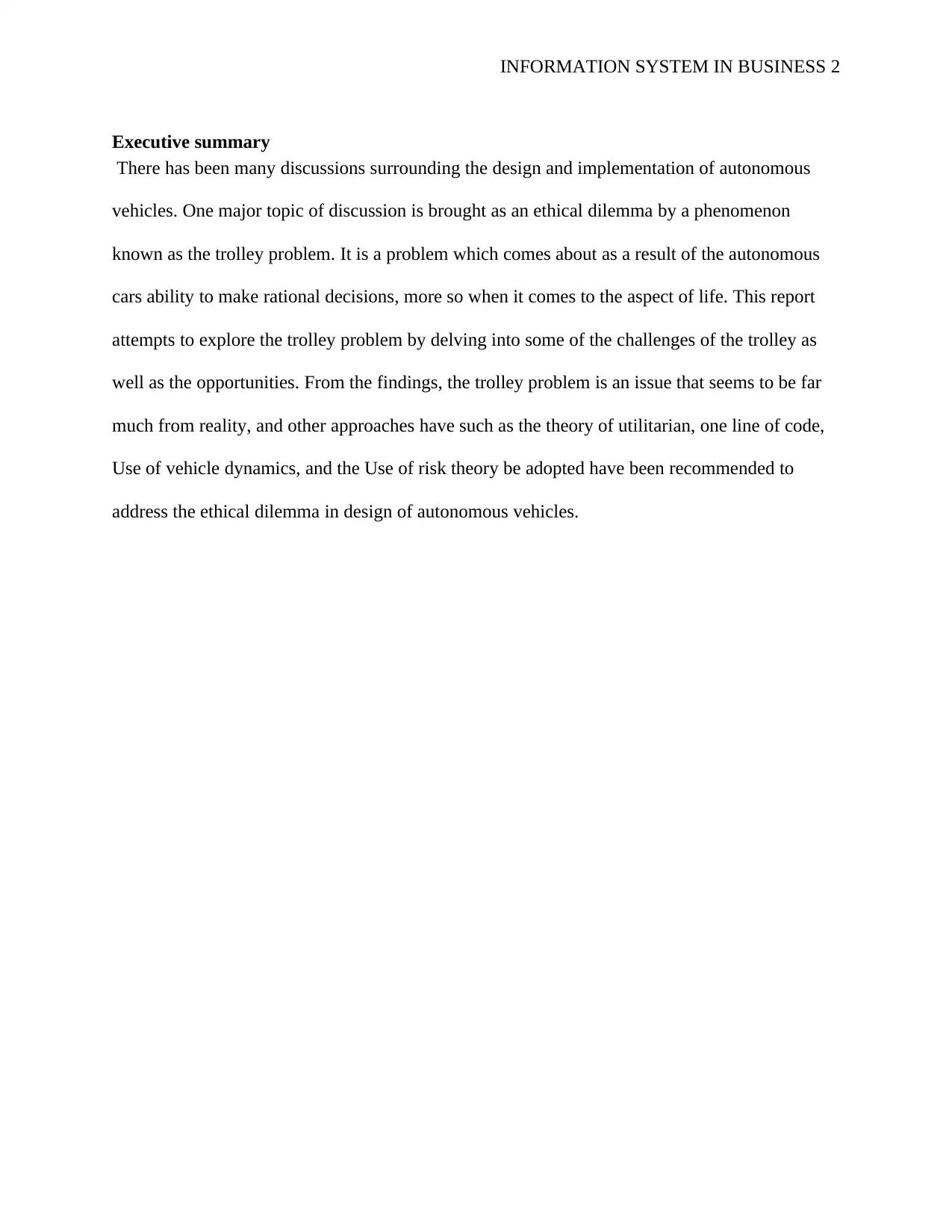
INFORMATION SYSTEM IN BUSINESS 2
Executive summary
There has been many discussions surrounding the design and implementation of autonomous
vehicles. One major topic of discussion is brought as an ethical dilemma by a phenomenon
known as the trolley problem. It is a problem which comes about as a result of the autonomous
cars ability to make rational decisions, more so when it comes to the aspect of life. This report
attempts to explore the trolley problem by delving into some of the challenges of the trolley as
well as the opportunities. From the findings, the trolley problem is an issue that seems to be far
much from reality, and other approaches have such as the theory of utilitarian, one line of code,
Use of vehicle dynamics, and the Use of risk theory be adopted have been recommended to
address the ethical dilemma in design of autonomous vehicles.
Executive summary
There has been many discussions surrounding the design and implementation of autonomous
vehicles. One major topic of discussion is brought as an ethical dilemma by a phenomenon
known as the trolley problem. It is a problem which comes about as a result of the autonomous
cars ability to make rational decisions, more so when it comes to the aspect of life. This report
attempts to explore the trolley problem by delving into some of the challenges of the trolley as
well as the opportunities. From the findings, the trolley problem is an issue that seems to be far
much from reality, and other approaches have such as the theory of utilitarian, one line of code,
Use of vehicle dynamics, and the Use of risk theory be adopted have been recommended to
address the ethical dilemma in design of autonomous vehicles.
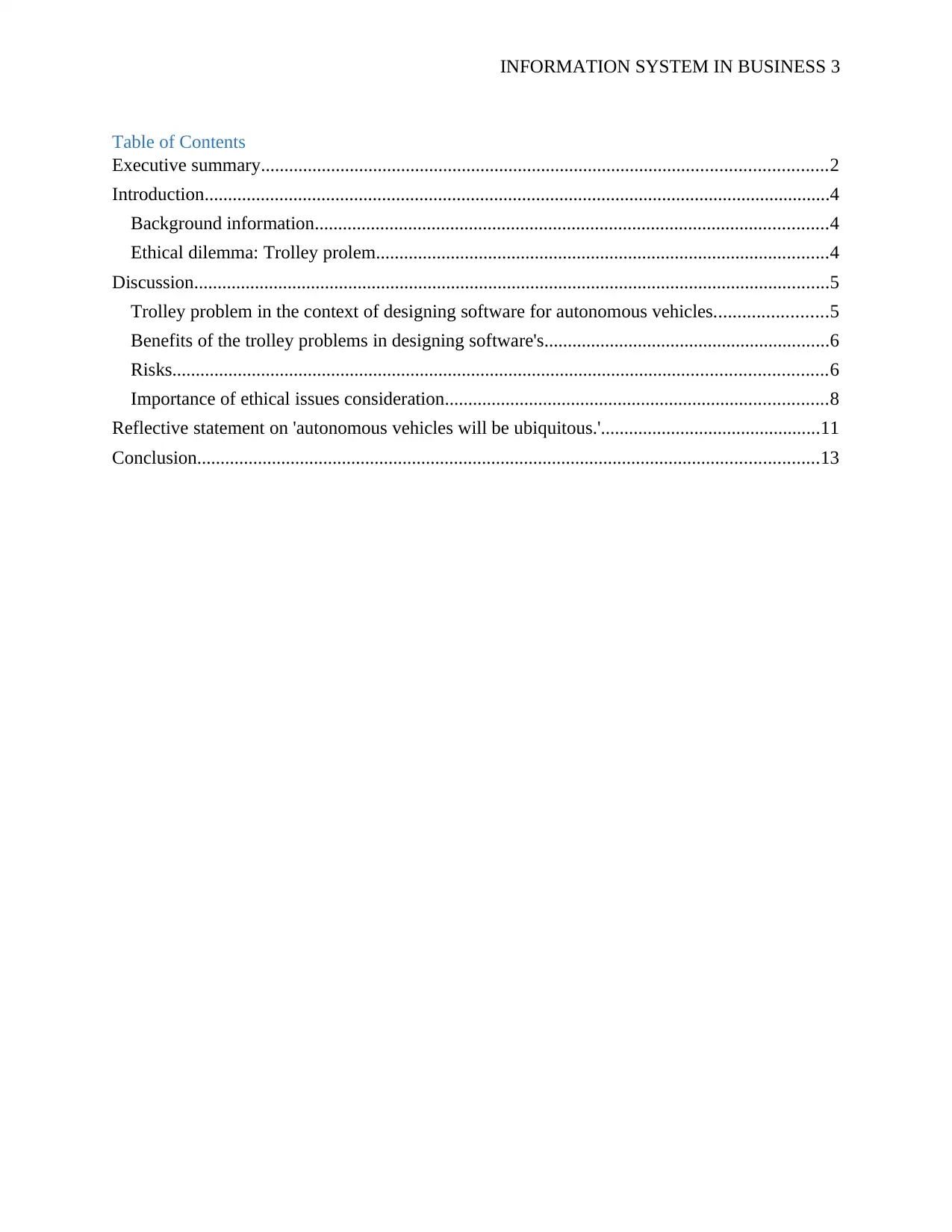
INFORMATION SYSTEM IN BUSINESS 3
Table of Contents
Executive summary.........................................................................................................................2
Introduction......................................................................................................................................4
Background information..............................................................................................................4
Ethical dilemma: Trolley prolem.................................................................................................4
Discussion........................................................................................................................................5
Trolley problem in the context of designing software for autonomous vehicles........................5
Benefits of the trolley problems in designing software's.............................................................6
Risks............................................................................................................................................6
Importance of ethical issues consideration..................................................................................8
Reflective statement on 'autonomous vehicles will be ubiquitous.'...............................................11
Conclusion.....................................................................................................................................13
Table of Contents
Executive summary.........................................................................................................................2
Introduction......................................................................................................................................4
Background information..............................................................................................................4
Ethical dilemma: Trolley prolem.................................................................................................4
Discussion........................................................................................................................................5
Trolley problem in the context of designing software for autonomous vehicles........................5
Benefits of the trolley problems in designing software's.............................................................6
Risks............................................................................................................................................6
Importance of ethical issues consideration..................................................................................8
Reflective statement on 'autonomous vehicles will be ubiquitous.'...............................................11
Conclusion.....................................................................................................................................13
⊘ This is a preview!⊘
Do you want full access?
Subscribe today to unlock all pages.

Trusted by 1+ million students worldwide
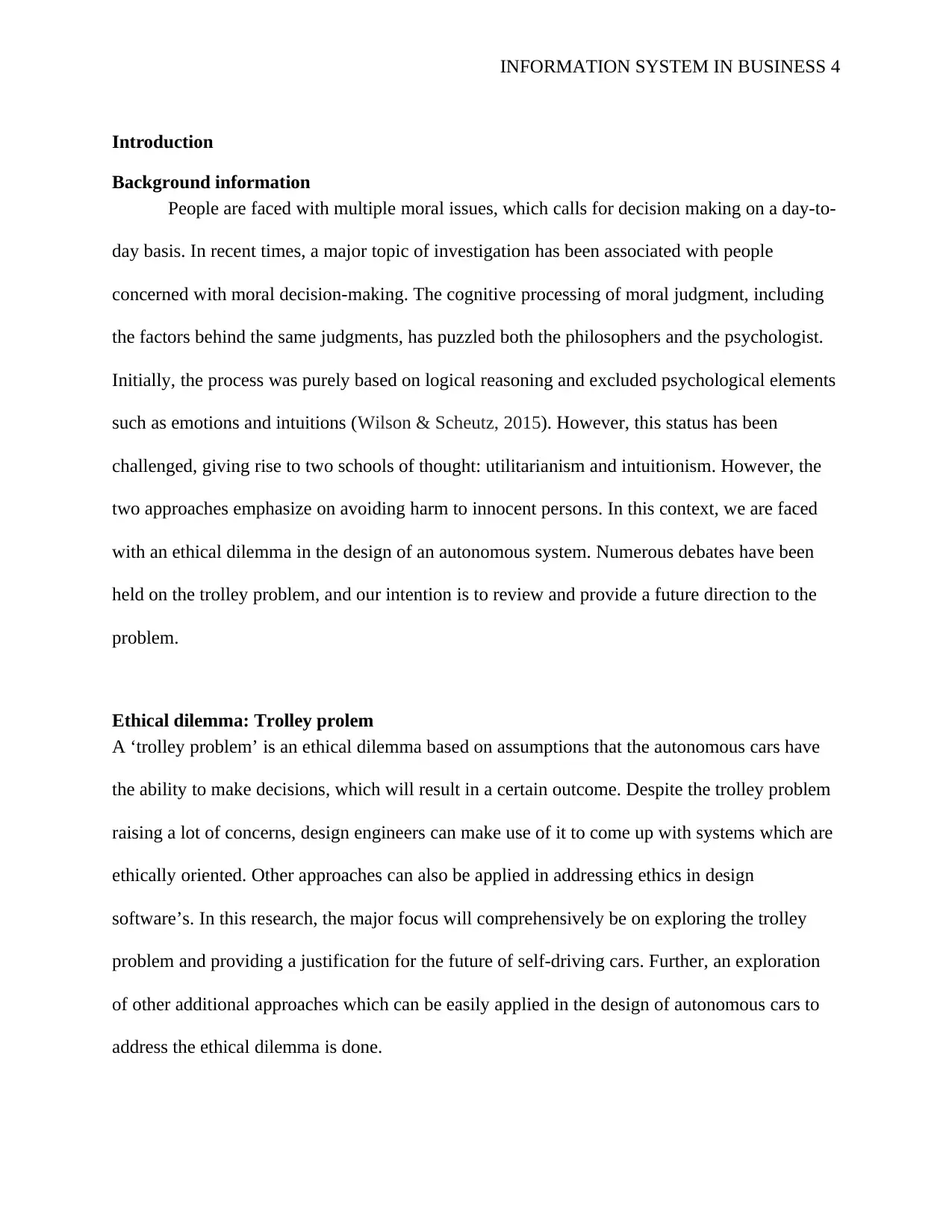
INFORMATION SYSTEM IN BUSINESS 4
Introduction
Background information
People are faced with multiple moral issues, which calls for decision making on a day-to-
day basis. In recent times, a major topic of investigation has been associated with people
concerned with moral decision-making. The cognitive processing of moral judgment, including
the factors behind the same judgments, has puzzled both the philosophers and the psychologist.
Initially, the process was purely based on logical reasoning and excluded psychological elements
such as emotions and intuitions (Wilson & Scheutz, 2015). However, this status has been
challenged, giving rise to two schools of thought: utilitarianism and intuitionism. However, the
two approaches emphasize on avoiding harm to innocent persons. In this context, we are faced
with an ethical dilemma in the design of an autonomous system. Numerous debates have been
held on the trolley problem, and our intention is to review and provide a future direction to the
problem.
Ethical dilemma: Trolley prolem
A ‘trolley problem’ is an ethical dilemma based on assumptions that the autonomous cars have
the ability to make decisions, which will result in a certain outcome. Despite the trolley problem
raising a lot of concerns, design engineers can make use of it to come up with systems which are
ethically oriented. Other approaches can also be applied in addressing ethics in design
software’s. In this research, the major focus will comprehensively be on exploring the trolley
problem and providing a justification for the future of self-driving cars. Further, an exploration
of other additional approaches which can be easily applied in the design of autonomous cars to
address the ethical dilemma is done.
Introduction
Background information
People are faced with multiple moral issues, which calls for decision making on a day-to-
day basis. In recent times, a major topic of investigation has been associated with people
concerned with moral decision-making. The cognitive processing of moral judgment, including
the factors behind the same judgments, has puzzled both the philosophers and the psychologist.
Initially, the process was purely based on logical reasoning and excluded psychological elements
such as emotions and intuitions (Wilson & Scheutz, 2015). However, this status has been
challenged, giving rise to two schools of thought: utilitarianism and intuitionism. However, the
two approaches emphasize on avoiding harm to innocent persons. In this context, we are faced
with an ethical dilemma in the design of an autonomous system. Numerous debates have been
held on the trolley problem, and our intention is to review and provide a future direction to the
problem.
Ethical dilemma: Trolley prolem
A ‘trolley problem’ is an ethical dilemma based on assumptions that the autonomous cars have
the ability to make decisions, which will result in a certain outcome. Despite the trolley problem
raising a lot of concerns, design engineers can make use of it to come up with systems which are
ethically oriented. Other approaches can also be applied in addressing ethics in design
software’s. In this research, the major focus will comprehensively be on exploring the trolley
problem and providing a justification for the future of self-driving cars. Further, an exploration
of other additional approaches which can be easily applied in the design of autonomous cars to
address the ethical dilemma is done.
Paraphrase This Document
Need a fresh take? Get an instant paraphrase of this document with our AI Paraphraser
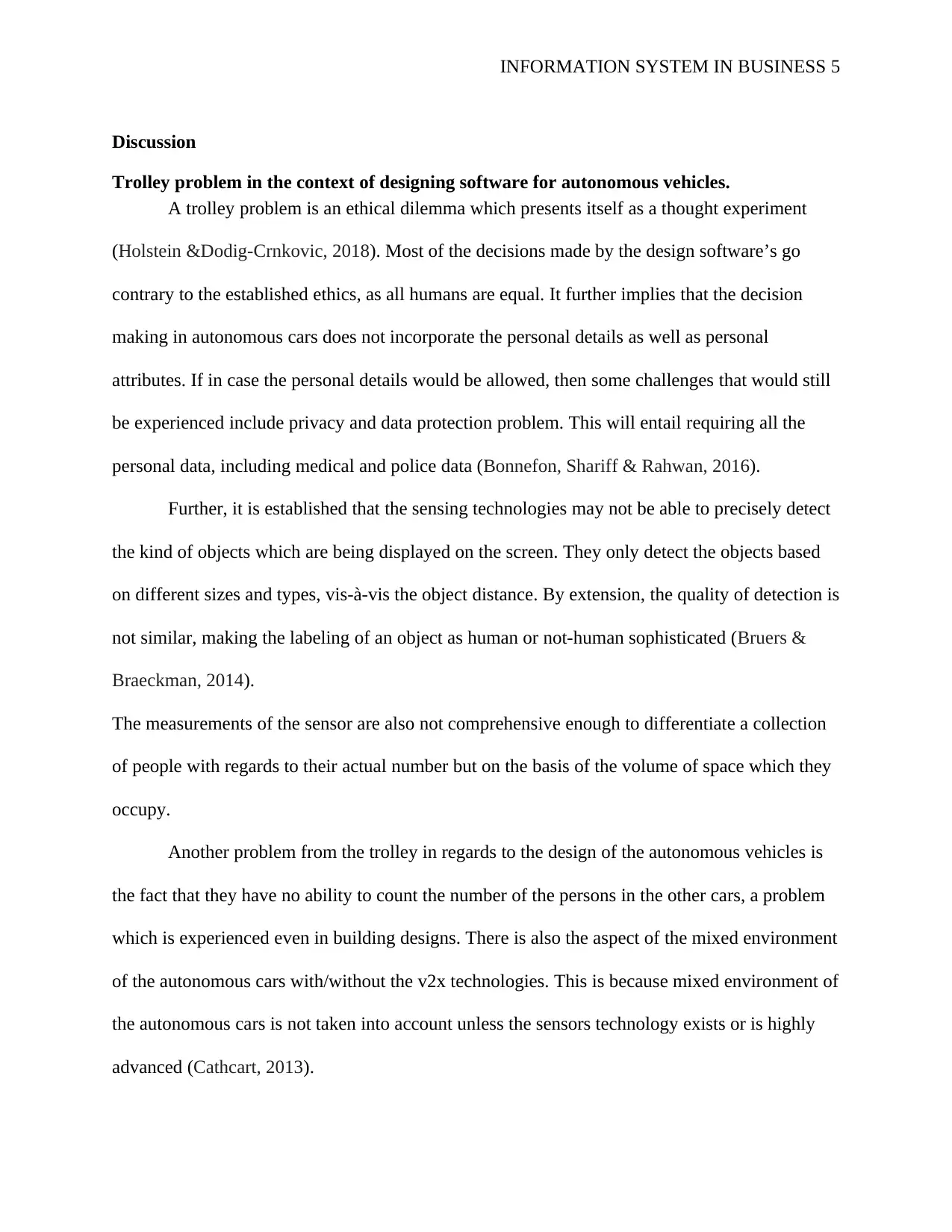
INFORMATION SYSTEM IN BUSINESS 5
Discussion
Trolley problem in the context of designing software for autonomous vehicles.
A trolley problem is an ethical dilemma which presents itself as a thought experiment
(Holstein &Dodig-Crnkovic, 2018). Most of the decisions made by the design software’s go
contrary to the established ethics, as all humans are equal. It further implies that the decision
making in autonomous cars does not incorporate the personal details as well as personal
attributes. If in case the personal details would be allowed, then some challenges that would still
be experienced include privacy and data protection problem. This will entail requiring all the
personal data, including medical and police data (Bonnefon, Shariff & Rahwan, 2016).
Further, it is established that the sensing technologies may not be able to precisely detect
the kind of objects which are being displayed on the screen. They only detect the objects based
on different sizes and types, vis-à-vis the object distance. By extension, the quality of detection is
not similar, making the labeling of an object as human or not-human sophisticated (Bruers &
Braeckman, 2014).
The measurements of the sensor are also not comprehensive enough to differentiate a collection
of people with regards to their actual number but on the basis of the volume of space which they
occupy.
Another problem from the trolley in regards to the design of the autonomous vehicles is
the fact that they have no ability to count the number of the persons in the other cars, a problem
which is experienced even in building designs. There is also the aspect of the mixed environment
of the autonomous cars with/without the v2x technologies. This is because mixed environment of
the autonomous cars is not taken into account unless the sensors technology exists or is highly
advanced (Cathcart, 2013).
Discussion
Trolley problem in the context of designing software for autonomous vehicles.
A trolley problem is an ethical dilemma which presents itself as a thought experiment
(Holstein &Dodig-Crnkovic, 2018). Most of the decisions made by the design software’s go
contrary to the established ethics, as all humans are equal. It further implies that the decision
making in autonomous cars does not incorporate the personal details as well as personal
attributes. If in case the personal details would be allowed, then some challenges that would still
be experienced include privacy and data protection problem. This will entail requiring all the
personal data, including medical and police data (Bonnefon, Shariff & Rahwan, 2016).
Further, it is established that the sensing technologies may not be able to precisely detect
the kind of objects which are being displayed on the screen. They only detect the objects based
on different sizes and types, vis-à-vis the object distance. By extension, the quality of detection is
not similar, making the labeling of an object as human or not-human sophisticated (Bruers &
Braeckman, 2014).
The measurements of the sensor are also not comprehensive enough to differentiate a collection
of people with regards to their actual number but on the basis of the volume of space which they
occupy.
Another problem from the trolley in regards to the design of the autonomous vehicles is
the fact that they have no ability to count the number of the persons in the other cars, a problem
which is experienced even in building designs. There is also the aspect of the mixed environment
of the autonomous cars with/without the v2x technologies. This is because mixed environment of
the autonomous cars is not taken into account unless the sensors technology exists or is highly
advanced (Cathcart, 2013).
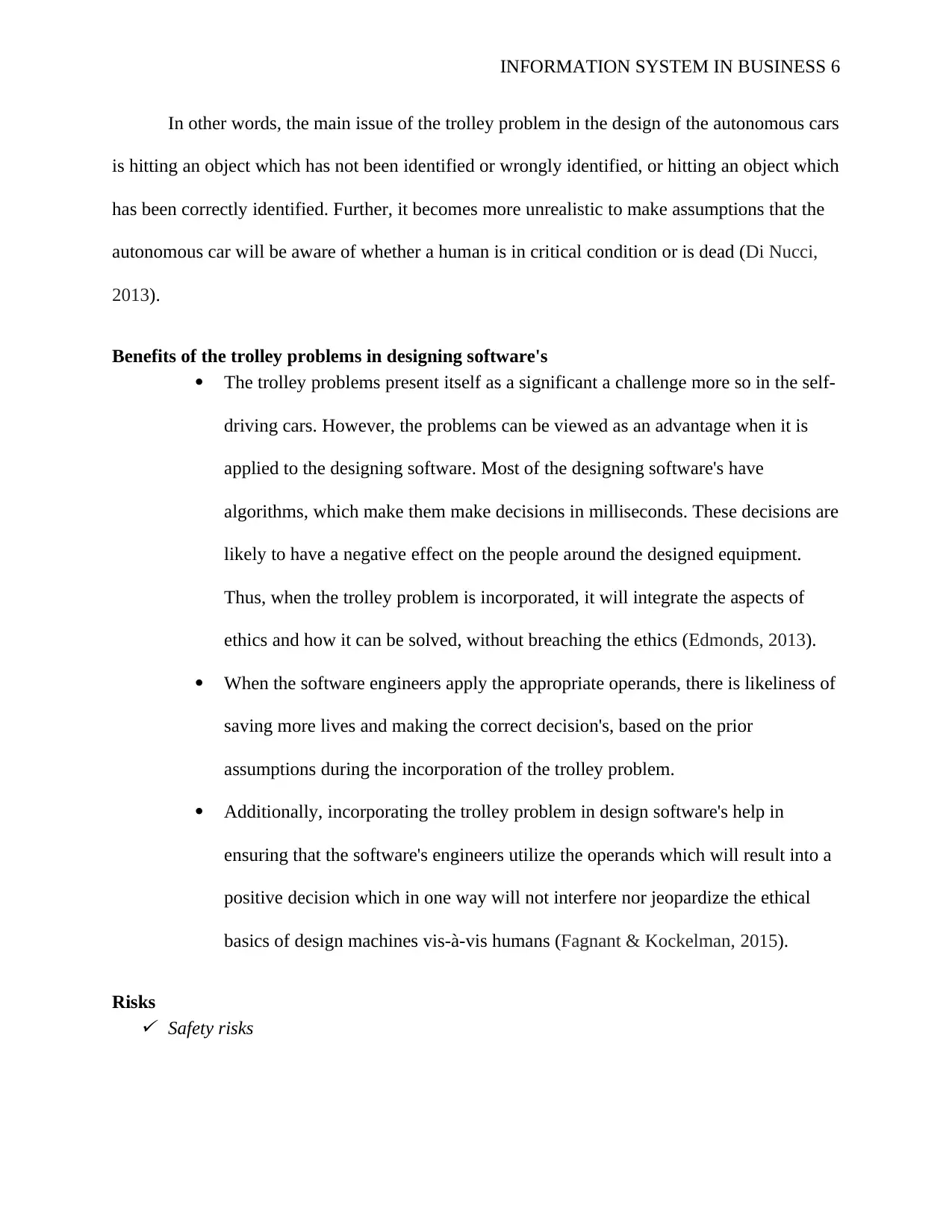
INFORMATION SYSTEM IN BUSINESS 6
In other words, the main issue of the trolley problem in the design of the autonomous cars
is hitting an object which has not been identified or wrongly identified, or hitting an object which
has been correctly identified. Further, it becomes more unrealistic to make assumptions that the
autonomous car will be aware of whether a human is in critical condition or is dead (Di Nucci,
2013).
Benefits of the trolley problems in designing software's
The trolley problems present itself as a significant a challenge more so in the self-
driving cars. However, the problems can be viewed as an advantage when it is
applied to the designing software. Most of the designing software's have
algorithms, which make them make decisions in milliseconds. These decisions are
likely to have a negative effect on the people around the designed equipment.
Thus, when the trolley problem is incorporated, it will integrate the aspects of
ethics and how it can be solved, without breaching the ethics (Edmonds, 2013).
When the software engineers apply the appropriate operands, there is likeliness of
saving more lives and making the correct decision's, based on the prior
assumptions during the incorporation of the trolley problem.
Additionally, incorporating the trolley problem in design software's help in
ensuring that the software's engineers utilize the operands which will result into a
positive decision which in one way will not interfere nor jeopardize the ethical
basics of design machines vis-à-vis humans (Fagnant & Kockelman, 2015).
Risks
Safety risks
In other words, the main issue of the trolley problem in the design of the autonomous cars
is hitting an object which has not been identified or wrongly identified, or hitting an object which
has been correctly identified. Further, it becomes more unrealistic to make assumptions that the
autonomous car will be aware of whether a human is in critical condition or is dead (Di Nucci,
2013).
Benefits of the trolley problems in designing software's
The trolley problems present itself as a significant a challenge more so in the self-
driving cars. However, the problems can be viewed as an advantage when it is
applied to the designing software. Most of the designing software's have
algorithms, which make them make decisions in milliseconds. These decisions are
likely to have a negative effect on the people around the designed equipment.
Thus, when the trolley problem is incorporated, it will integrate the aspects of
ethics and how it can be solved, without breaching the ethics (Edmonds, 2013).
When the software engineers apply the appropriate operands, there is likeliness of
saving more lives and making the correct decision's, based on the prior
assumptions during the incorporation of the trolley problem.
Additionally, incorporating the trolley problem in design software's help in
ensuring that the software's engineers utilize the operands which will result into a
positive decision which in one way will not interfere nor jeopardize the ethical
basics of design machines vis-à-vis humans (Fagnant & Kockelman, 2015).
Risks
Safety risks
⊘ This is a preview!⊘
Do you want full access?
Subscribe today to unlock all pages.

Trusted by 1+ million students worldwide
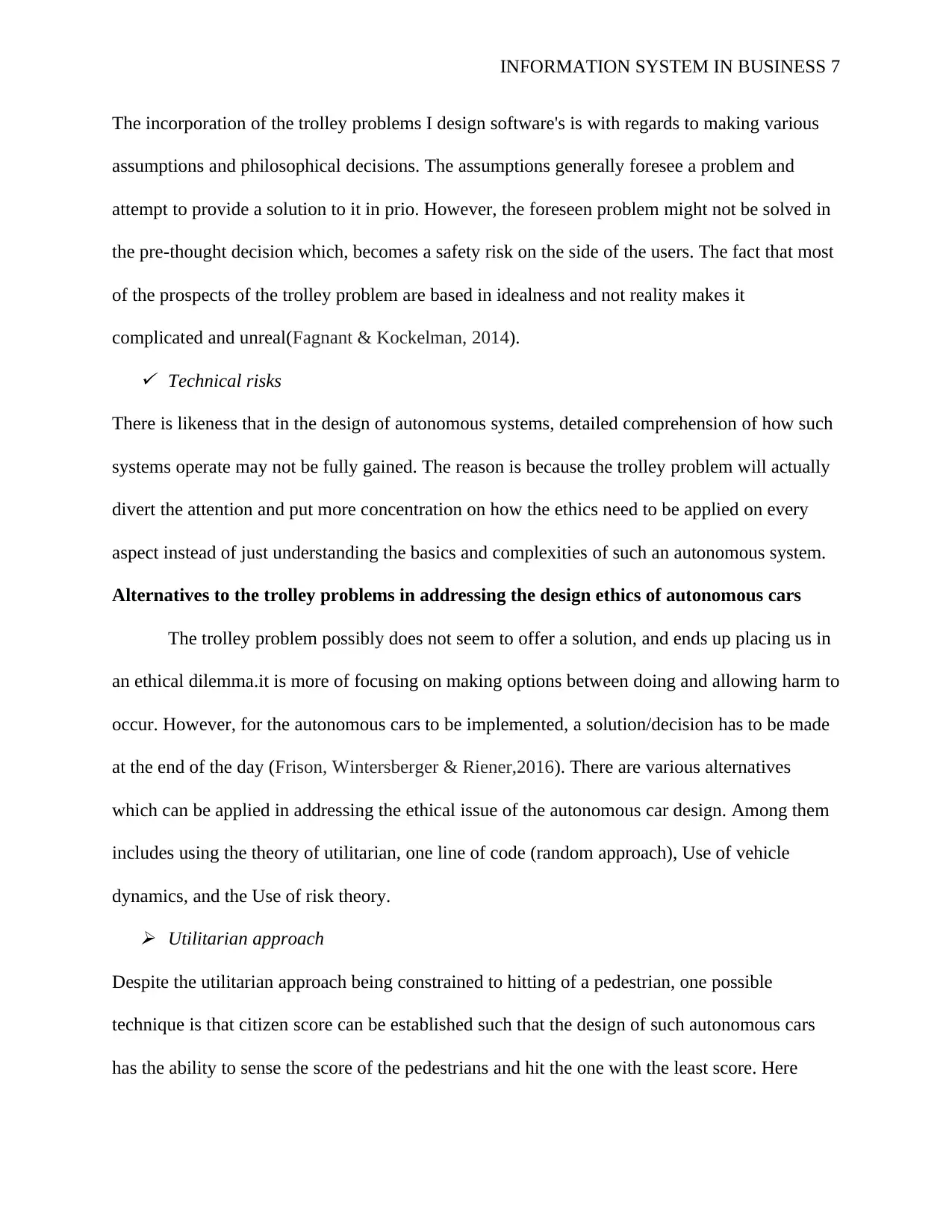
INFORMATION SYSTEM IN BUSINESS 7
The incorporation of the trolley problems I design software's is with regards to making various
assumptions and philosophical decisions. The assumptions generally foresee a problem and
attempt to provide a solution to it in prio. However, the foreseen problem might not be solved in
the pre-thought decision which, becomes a safety risk on the side of the users. The fact that most
of the prospects of the trolley problem are based in idealness and not reality makes it
complicated and unreal(Fagnant & Kockelman, 2014). Technical risks
There is likeness that in the design of autonomous systems, detailed comprehension of how such
systems operate may not be fully gained. The reason is because the trolley problem will actually
divert the attention and put more concentration on how the ethics need to be applied on every
aspect instead of just understanding the basics and complexities of such an autonomous system.
Alternatives to the trolley problems in addressing the design ethics of autonomous cars
The trolley problem possibly does not seem to offer a solution, and ends up placing us in
an ethical dilemma.it is more of focusing on making options between doing and allowing harm to
occur. However, for the autonomous cars to be implemented, a solution/decision has to be made
at the end of the day (Frison, Wintersberger & Riener,2016). There are various alternatives
which can be applied in addressing the ethical issue of the autonomous car design. Among them
includes using the theory of utilitarian, one line of code (random approach), Use of vehicle
dynamics, and the Use of risk theory. Utilitarian approach
Despite the utilitarian approach being constrained to hitting of a pedestrian, one possible
technique is that citizen score can be established such that the design of such autonomous cars
has the ability to sense the score of the pedestrians and hit the one with the least score. Here
The incorporation of the trolley problems I design software's is with regards to making various
assumptions and philosophical decisions. The assumptions generally foresee a problem and
attempt to provide a solution to it in prio. However, the foreseen problem might not be solved in
the pre-thought decision which, becomes a safety risk on the side of the users. The fact that most
of the prospects of the trolley problem are based in idealness and not reality makes it
complicated and unreal(Fagnant & Kockelman, 2014). Technical risks
There is likeness that in the design of autonomous systems, detailed comprehension of how such
systems operate may not be fully gained. The reason is because the trolley problem will actually
divert the attention and put more concentration on how the ethics need to be applied on every
aspect instead of just understanding the basics and complexities of such an autonomous system.
Alternatives to the trolley problems in addressing the design ethics of autonomous cars
The trolley problem possibly does not seem to offer a solution, and ends up placing us in
an ethical dilemma.it is more of focusing on making options between doing and allowing harm to
occur. However, for the autonomous cars to be implemented, a solution/decision has to be made
at the end of the day (Frison, Wintersberger & Riener,2016). There are various alternatives
which can be applied in addressing the ethical issue of the autonomous car design. Among them
includes using the theory of utilitarian, one line of code (random approach), Use of vehicle
dynamics, and the Use of risk theory. Utilitarian approach
Despite the utilitarian approach being constrained to hitting of a pedestrian, one possible
technique is that citizen score can be established such that the design of such autonomous cars
has the ability to sense the score of the pedestrians and hit the one with the least score. Here
Paraphrase This Document
Need a fresh take? Get an instant paraphrase of this document with our AI Paraphraser
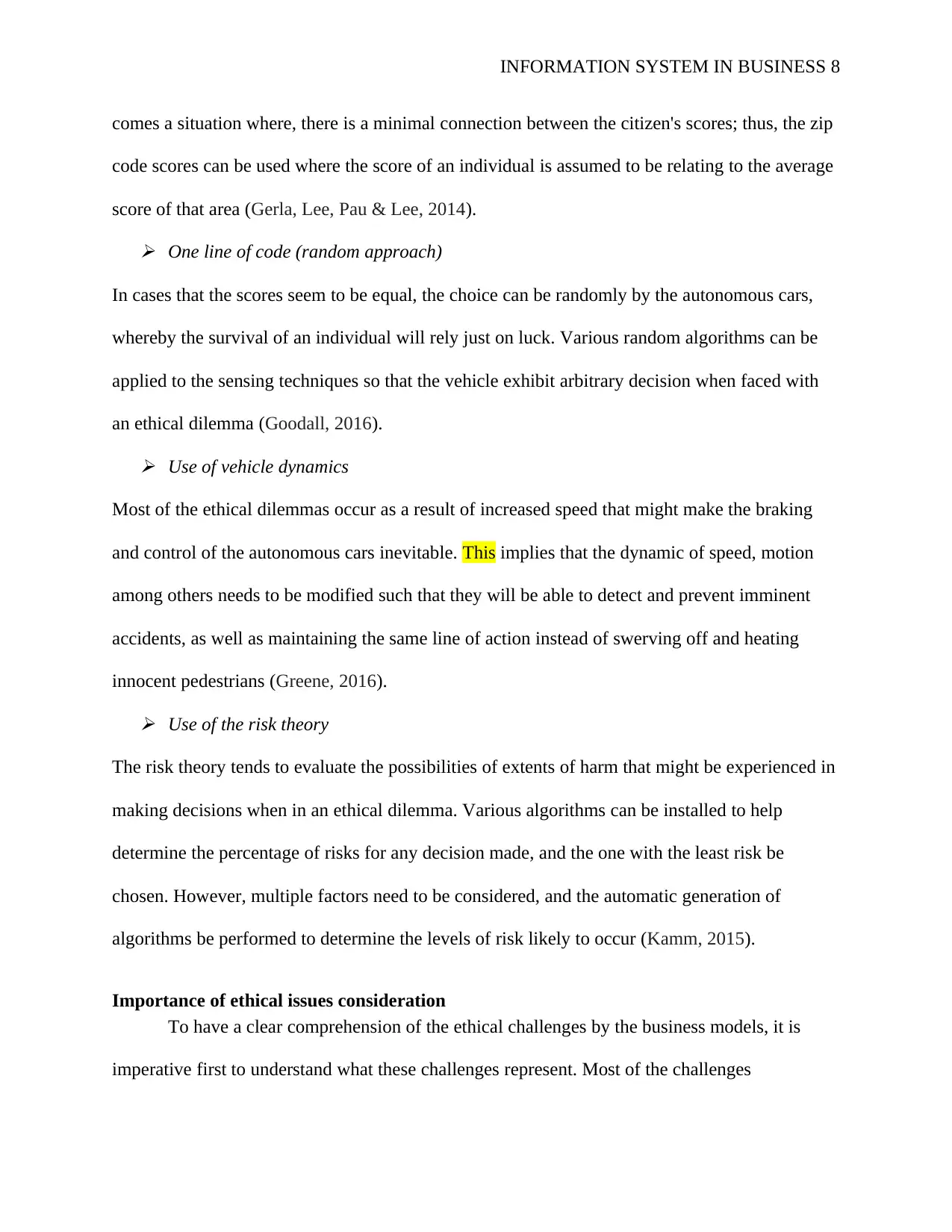
INFORMATION SYSTEM IN BUSINESS 8
comes a situation where, there is a minimal connection between the citizen's scores; thus, the zip
code scores can be used where the score of an individual is assumed to be relating to the average
score of that area (Gerla, Lee, Pau & Lee, 2014). One line of code (random approach)
In cases that the scores seem to be equal, the choice can be randomly by the autonomous cars,
whereby the survival of an individual will rely just on luck. Various random algorithms can be
applied to the sensing techniques so that the vehicle exhibit arbitrary decision when faced with
an ethical dilemma (Goodall, 2016). Use of vehicle dynamics
Most of the ethical dilemmas occur as a result of increased speed that might make the braking
and control of the autonomous cars inevitable. This implies that the dynamic of speed, motion
among others needs to be modified such that they will be able to detect and prevent imminent
accidents, as well as maintaining the same line of action instead of swerving off and heating
innocent pedestrians (Greene, 2016). Use of the risk theory
The risk theory tends to evaluate the possibilities of extents of harm that might be experienced in
making decisions when in an ethical dilemma. Various algorithms can be installed to help
determine the percentage of risks for any decision made, and the one with the least risk be
chosen. However, multiple factors need to be considered, and the automatic generation of
algorithms be performed to determine the levels of risk likely to occur (Kamm, 2015).
Importance of ethical issues consideration
To have a clear comprehension of the ethical challenges by the business models, it is
imperative first to understand what these challenges represent. Most of the challenges
comes a situation where, there is a minimal connection between the citizen's scores; thus, the zip
code scores can be used where the score of an individual is assumed to be relating to the average
score of that area (Gerla, Lee, Pau & Lee, 2014). One line of code (random approach)
In cases that the scores seem to be equal, the choice can be randomly by the autonomous cars,
whereby the survival of an individual will rely just on luck. Various random algorithms can be
applied to the sensing techniques so that the vehicle exhibit arbitrary decision when faced with
an ethical dilemma (Goodall, 2016). Use of vehicle dynamics
Most of the ethical dilemmas occur as a result of increased speed that might make the braking
and control of the autonomous cars inevitable. This implies that the dynamic of speed, motion
among others needs to be modified such that they will be able to detect and prevent imminent
accidents, as well as maintaining the same line of action instead of swerving off and heating
innocent pedestrians (Greene, 2016). Use of the risk theory
The risk theory tends to evaluate the possibilities of extents of harm that might be experienced in
making decisions when in an ethical dilemma. Various algorithms can be installed to help
determine the percentage of risks for any decision made, and the one with the least risk be
chosen. However, multiple factors need to be considered, and the automatic generation of
algorithms be performed to determine the levels of risk likely to occur (Kamm, 2015).
Importance of ethical issues consideration
To have a clear comprehension of the ethical challenges by the business models, it is
imperative first to understand what these challenges represent. Most of the challenges
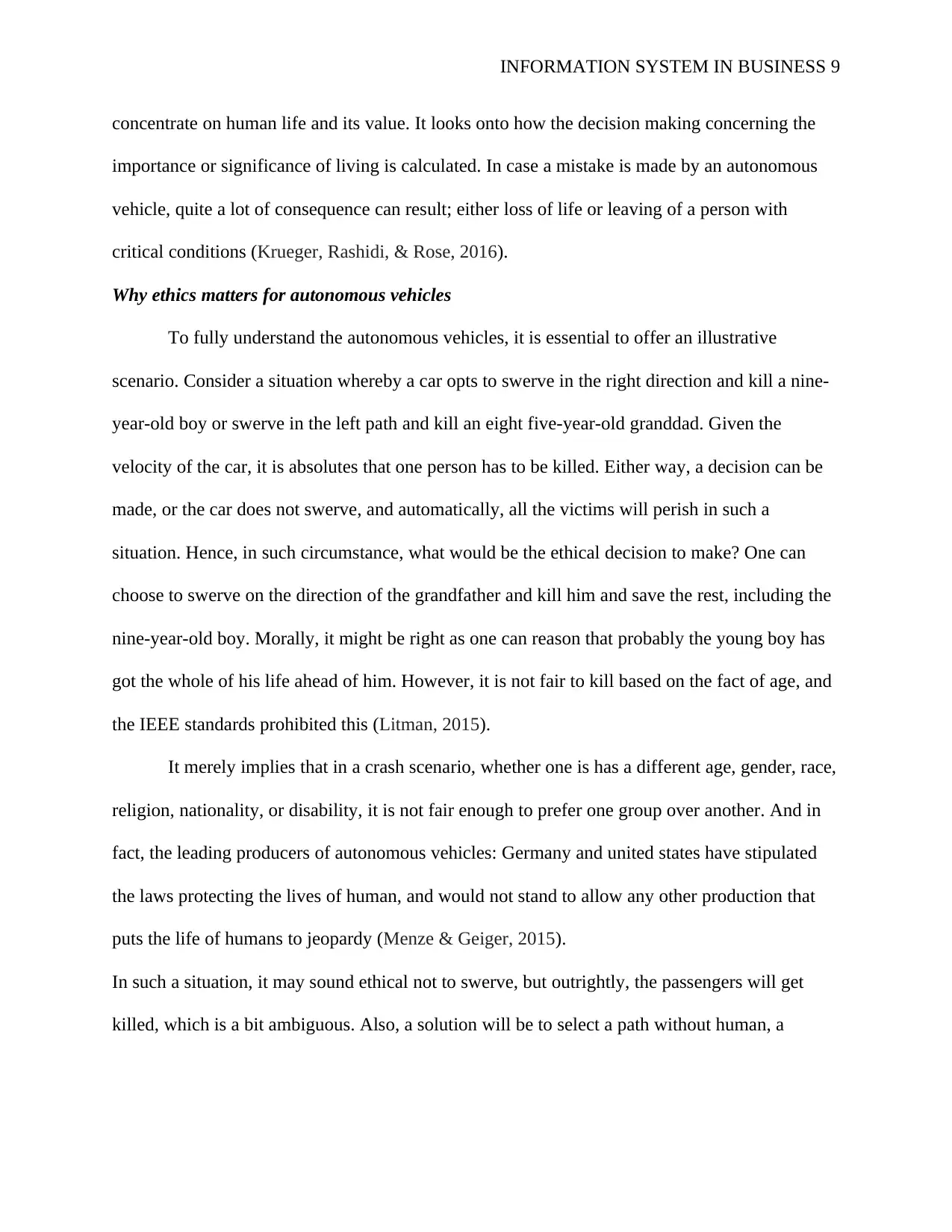
INFORMATION SYSTEM IN BUSINESS 9
concentrate on human life and its value. It looks onto how the decision making concerning the
importance or significance of living is calculated. In case a mistake is made by an autonomous
vehicle, quite a lot of consequence can result; either loss of life or leaving of a person with
critical conditions (Krueger, Rashidi, & Rose, 2016).
Why ethics matters for autonomous vehicles
To fully understand the autonomous vehicles, it is essential to offer an illustrative
scenario. Consider a situation whereby a car opts to swerve in the right direction and kill a nine-
year-old boy or swerve in the left path and kill an eight five-year-old granddad. Given the
velocity of the car, it is absolutes that one person has to be killed. Either way, a decision can be
made, or the car does not swerve, and automatically, all the victims will perish in such a
situation. Hence, in such circumstance, what would be the ethical decision to make? One can
choose to swerve on the direction of the grandfather and kill him and save the rest, including the
nine-year-old boy. Morally, it might be right as one can reason that probably the young boy has
got the whole of his life ahead of him. However, it is not fair to kill based on the fact of age, and
the IEEE standards prohibited this (Litman, 2015).
It merely implies that in a crash scenario, whether one is has a different age, gender, race,
religion, nationality, or disability, it is not fair enough to prefer one group over another. And in
fact, the leading producers of autonomous vehicles: Germany and united states have stipulated
the laws protecting the lives of human, and would not stand to allow any other production that
puts the life of humans to jeopardy (Menze & Geiger, 2015).
In such a situation, it may sound ethical not to swerve, but outrightly, the passengers will get
killed, which is a bit ambiguous. Also, a solution will be to select a path without human, a
concentrate on human life and its value. It looks onto how the decision making concerning the
importance or significance of living is calculated. In case a mistake is made by an autonomous
vehicle, quite a lot of consequence can result; either loss of life or leaving of a person with
critical conditions (Krueger, Rashidi, & Rose, 2016).
Why ethics matters for autonomous vehicles
To fully understand the autonomous vehicles, it is essential to offer an illustrative
scenario. Consider a situation whereby a car opts to swerve in the right direction and kill a nine-
year-old boy or swerve in the left path and kill an eight five-year-old granddad. Given the
velocity of the car, it is absolutes that one person has to be killed. Either way, a decision can be
made, or the car does not swerve, and automatically, all the victims will perish in such a
situation. Hence, in such circumstance, what would be the ethical decision to make? One can
choose to swerve on the direction of the grandfather and kill him and save the rest, including the
nine-year-old boy. Morally, it might be right as one can reason that probably the young boy has
got the whole of his life ahead of him. However, it is not fair to kill based on the fact of age, and
the IEEE standards prohibited this (Litman, 2015).
It merely implies that in a crash scenario, whether one is has a different age, gender, race,
religion, nationality, or disability, it is not fair enough to prefer one group over another. And in
fact, the leading producers of autonomous vehicles: Germany and united states have stipulated
the laws protecting the lives of human, and would not stand to allow any other production that
puts the life of humans to jeopardy (Menze & Geiger, 2015).
In such a situation, it may sound ethical not to swerve, but outrightly, the passengers will get
killed, which is a bit ambiguous. Also, a solution will be to select a path without human, a
⊘ This is a preview!⊘
Do you want full access?
Subscribe today to unlock all pages.

Trusted by 1+ million students worldwide
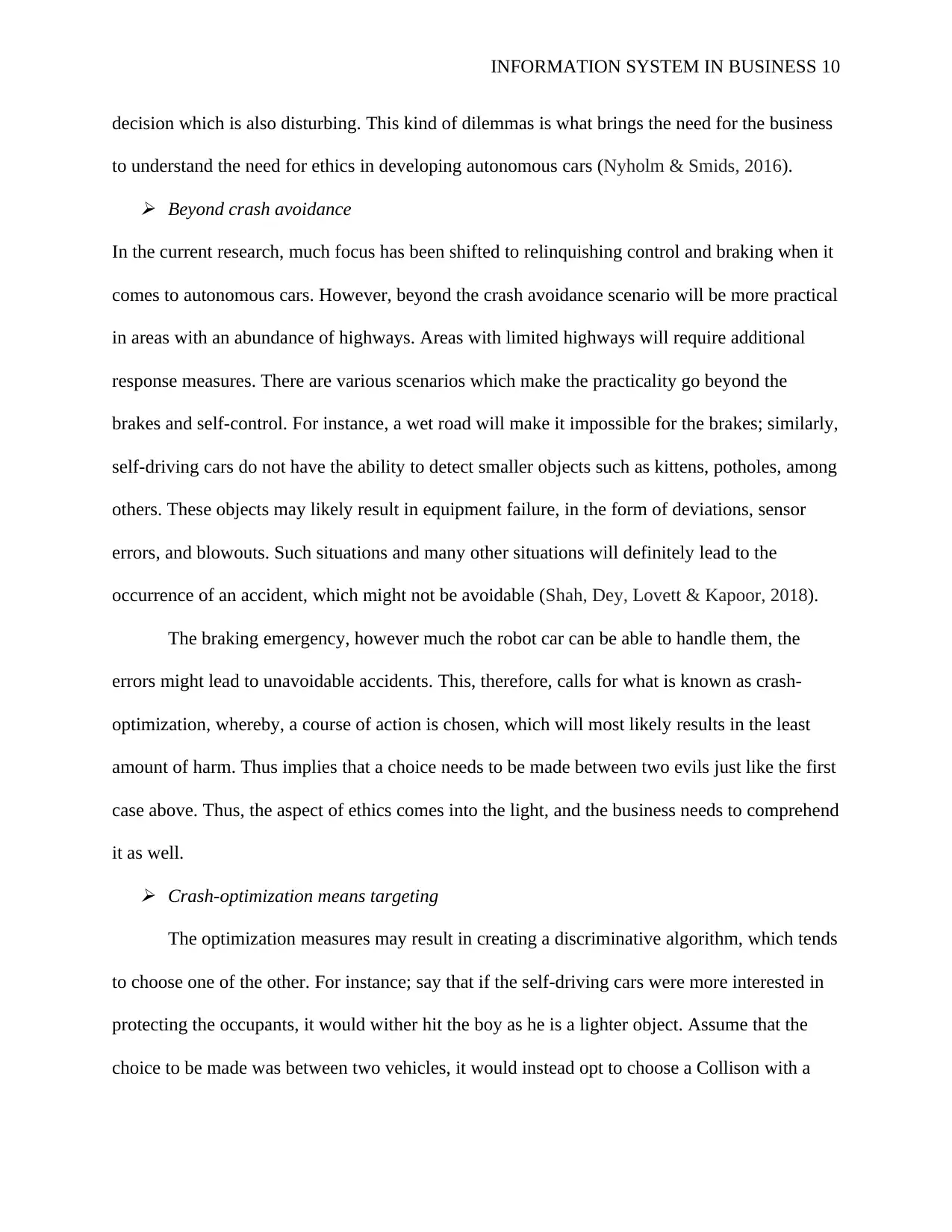
INFORMATION SYSTEM IN BUSINESS 10
decision which is also disturbing. This kind of dilemmas is what brings the need for the business
to understand the need for ethics in developing autonomous cars (Nyholm & Smids, 2016). Beyond crash avoidance
In the current research, much focus has been shifted to relinquishing control and braking when it
comes to autonomous cars. However, beyond the crash avoidance scenario will be more practical
in areas with an abundance of highways. Areas with limited highways will require additional
response measures. There are various scenarios which make the practicality go beyond the
brakes and self-control. For instance, a wet road will make it impossible for the brakes; similarly,
self-driving cars do not have the ability to detect smaller objects such as kittens, potholes, among
others. These objects may likely result in equipment failure, in the form of deviations, sensor
errors, and blowouts. Such situations and many other situations will definitely lead to the
occurrence of an accident, which might not be avoidable (Shah, Dey, Lovett & Kapoor, 2018).
The braking emergency, however much the robot car can be able to handle them, the
errors might lead to unavoidable accidents. This, therefore, calls for what is known as crash-
optimization, whereby, a course of action is chosen, which will most likely results in the least
amount of harm. Thus implies that a choice needs to be made between two evils just like the first
case above. Thus, the aspect of ethics comes into the light, and the business needs to comprehend
it as well. Crash-optimization means targeting
The optimization measures may result in creating a discriminative algorithm, which tends
to choose one of the other. For instance; say that if the self-driving cars were more interested in
protecting the occupants, it would wither hit the boy as he is a lighter object. Assume that the
choice to be made was between two vehicles, it would instead opt to choose a Collison with a
decision which is also disturbing. This kind of dilemmas is what brings the need for the business
to understand the need for ethics in developing autonomous cars (Nyholm & Smids, 2016). Beyond crash avoidance
In the current research, much focus has been shifted to relinquishing control and braking when it
comes to autonomous cars. However, beyond the crash avoidance scenario will be more practical
in areas with an abundance of highways. Areas with limited highways will require additional
response measures. There are various scenarios which make the practicality go beyond the
brakes and self-control. For instance, a wet road will make it impossible for the brakes; similarly,
self-driving cars do not have the ability to detect smaller objects such as kittens, potholes, among
others. These objects may likely result in equipment failure, in the form of deviations, sensor
errors, and blowouts. Such situations and many other situations will definitely lead to the
occurrence of an accident, which might not be avoidable (Shah, Dey, Lovett & Kapoor, 2018).
The braking emergency, however much the robot car can be able to handle them, the
errors might lead to unavoidable accidents. This, therefore, calls for what is known as crash-
optimization, whereby, a course of action is chosen, which will most likely results in the least
amount of harm. Thus implies that a choice needs to be made between two evils just like the first
case above. Thus, the aspect of ethics comes into the light, and the business needs to comprehend
it as well. Crash-optimization means targeting
The optimization measures may result in creating a discriminative algorithm, which tends
to choose one of the other. For instance; say that if the self-driving cars were more interested in
protecting the occupants, it would wither hit the boy as he is a lighter object. Assume that the
choice to be made was between two vehicles, it would instead opt to choose a Collison with a
Paraphrase This Document
Need a fresh take? Get an instant paraphrase of this document with our AI Paraphraser
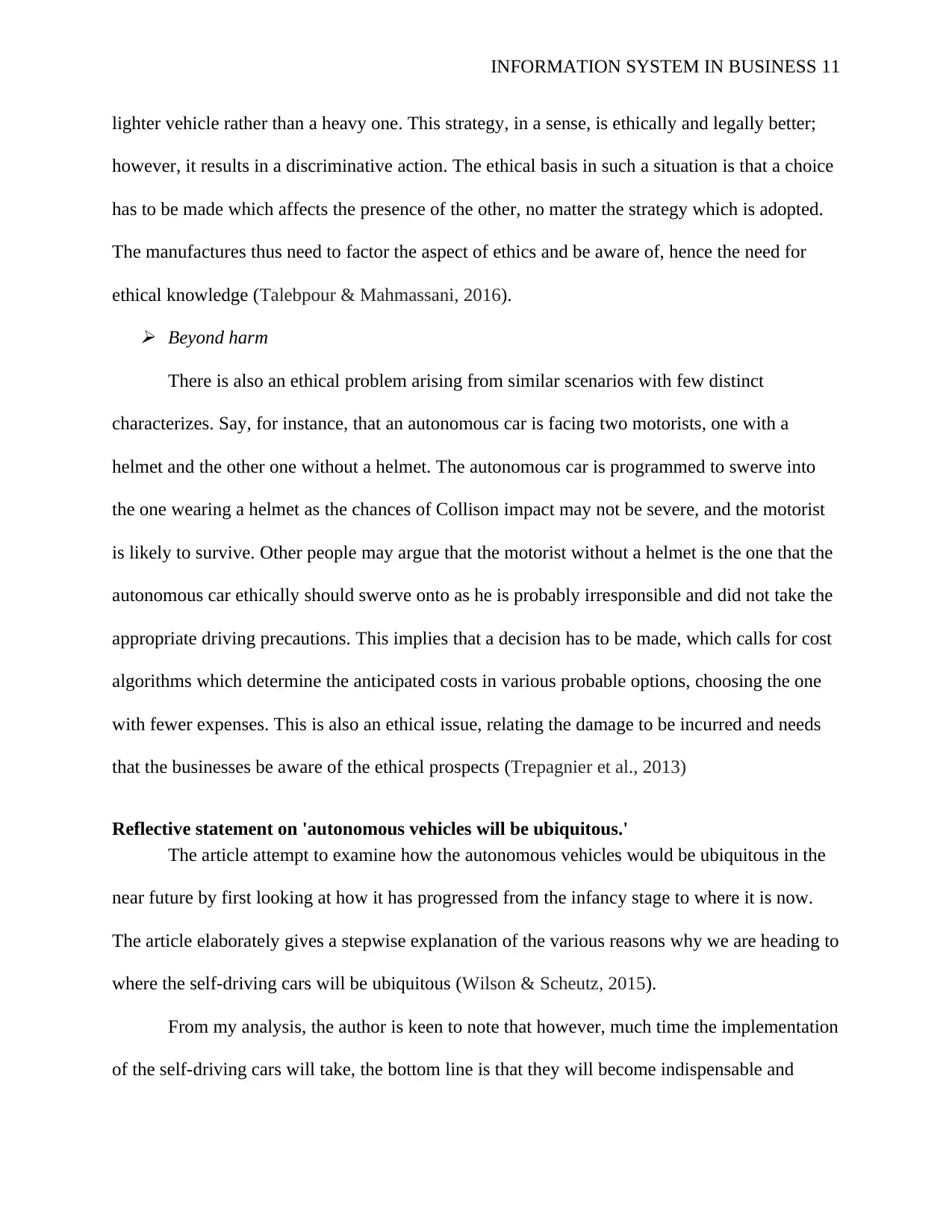
INFORMATION SYSTEM IN BUSINESS 11
lighter vehicle rather than a heavy one. This strategy, in a sense, is ethically and legally better;
however, it results in a discriminative action. The ethical basis in such a situation is that a choice
has to be made which affects the presence of the other, no matter the strategy which is adopted.
The manufactures thus need to factor the aspect of ethics and be aware of, hence the need for
ethical knowledge (Talebpour & Mahmassani, 2016). Beyond harm
There is also an ethical problem arising from similar scenarios with few distinct
characterizes. Say, for instance, that an autonomous car is facing two motorists, one with a
helmet and the other one without a helmet. The autonomous car is programmed to swerve into
the one wearing a helmet as the chances of Collison impact may not be severe, and the motorist
is likely to survive. Other people may argue that the motorist without a helmet is the one that the
autonomous car ethically should swerve onto as he is probably irresponsible and did not take the
appropriate driving precautions. This implies that a decision has to be made, which calls for cost
algorithms which determine the anticipated costs in various probable options, choosing the one
with fewer expenses. This is also an ethical issue, relating the damage to be incurred and needs
that the businesses be aware of the ethical prospects (Trepagnier et al., 2013)
Reflective statement on 'autonomous vehicles will be ubiquitous.'
The article attempt to examine how the autonomous vehicles would be ubiquitous in the
near future by first looking at how it has progressed from the infancy stage to where it is now.
The article elaborately gives a stepwise explanation of the various reasons why we are heading to
where the self-driving cars will be ubiquitous (Wilson & Scheutz, 2015).
From my analysis, the author is keen to note that however, much time the implementation
of the self-driving cars will take, the bottom line is that they will become indispensable and
lighter vehicle rather than a heavy one. This strategy, in a sense, is ethically and legally better;
however, it results in a discriminative action. The ethical basis in such a situation is that a choice
has to be made which affects the presence of the other, no matter the strategy which is adopted.
The manufactures thus need to factor the aspect of ethics and be aware of, hence the need for
ethical knowledge (Talebpour & Mahmassani, 2016). Beyond harm
There is also an ethical problem arising from similar scenarios with few distinct
characterizes. Say, for instance, that an autonomous car is facing two motorists, one with a
helmet and the other one without a helmet. The autonomous car is programmed to swerve into
the one wearing a helmet as the chances of Collison impact may not be severe, and the motorist
is likely to survive. Other people may argue that the motorist without a helmet is the one that the
autonomous car ethically should swerve onto as he is probably irresponsible and did not take the
appropriate driving precautions. This implies that a decision has to be made, which calls for cost
algorithms which determine the anticipated costs in various probable options, choosing the one
with fewer expenses. This is also an ethical issue, relating the damage to be incurred and needs
that the businesses be aware of the ethical prospects (Trepagnier et al., 2013)
Reflective statement on 'autonomous vehicles will be ubiquitous.'
The article attempt to examine how the autonomous vehicles would be ubiquitous in the
near future by first looking at how it has progressed from the infancy stage to where it is now.
The article elaborately gives a stepwise explanation of the various reasons why we are heading to
where the self-driving cars will be ubiquitous (Wilson & Scheutz, 2015).
From my analysis, the author is keen to note that however, much time the implementation
of the self-driving cars will take, the bottom line is that they will become indispensable and
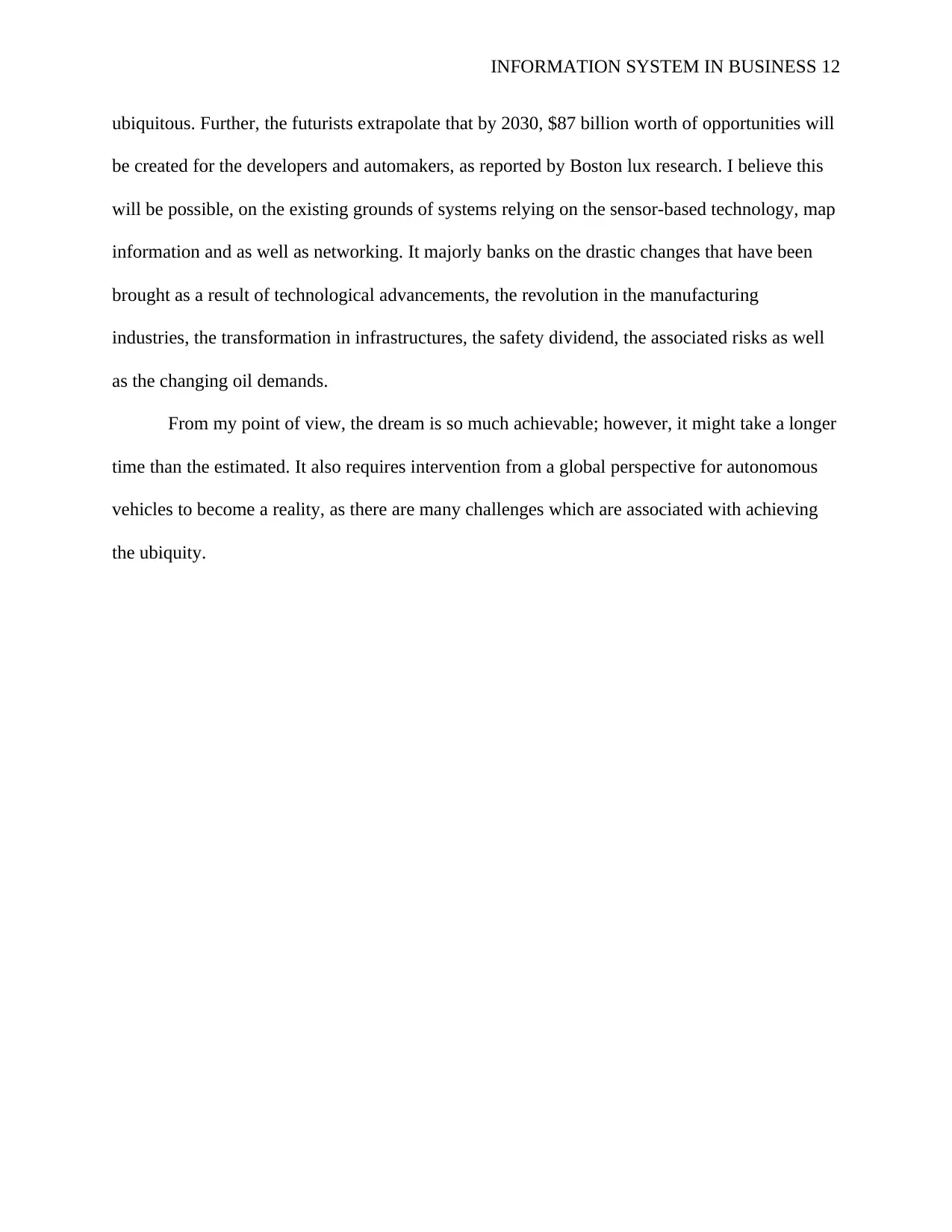
INFORMATION SYSTEM IN BUSINESS 12
ubiquitous. Further, the futurists extrapolate that by 2030, $87 billion worth of opportunities will
be created for the developers and automakers, as reported by Boston lux research. I believe this
will be possible, on the existing grounds of systems relying on the sensor-based technology, map
information and as well as networking. It majorly banks on the drastic changes that have been
brought as a result of technological advancements, the revolution in the manufacturing
industries, the transformation in infrastructures, the safety dividend, the associated risks as well
as the changing oil demands.
From my point of view, the dream is so much achievable; however, it might take a longer
time than the estimated. It also requires intervention from a global perspective for autonomous
vehicles to become a reality, as there are many challenges which are associated with achieving
the ubiquity.
ubiquitous. Further, the futurists extrapolate that by 2030, $87 billion worth of opportunities will
be created for the developers and automakers, as reported by Boston lux research. I believe this
will be possible, on the existing grounds of systems relying on the sensor-based technology, map
information and as well as networking. It majorly banks on the drastic changes that have been
brought as a result of technological advancements, the revolution in the manufacturing
industries, the transformation in infrastructures, the safety dividend, the associated risks as well
as the changing oil demands.
From my point of view, the dream is so much achievable; however, it might take a longer
time than the estimated. It also requires intervention from a global perspective for autonomous
vehicles to become a reality, as there are many challenges which are associated with achieving
the ubiquity.
⊘ This is a preview!⊘
Do you want full access?
Subscribe today to unlock all pages.

Trusted by 1+ million students worldwide
1 out of 15
Related Documents
Your All-in-One AI-Powered Toolkit for Academic Success.
+13062052269
info@desklib.com
Available 24*7 on WhatsApp / Email
![[object Object]](/_next/static/media/star-bottom.7253800d.svg)
Unlock your academic potential
Copyright © 2020–2025 A2Z Services. All Rights Reserved. Developed and managed by ZUCOL.





